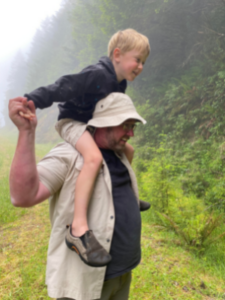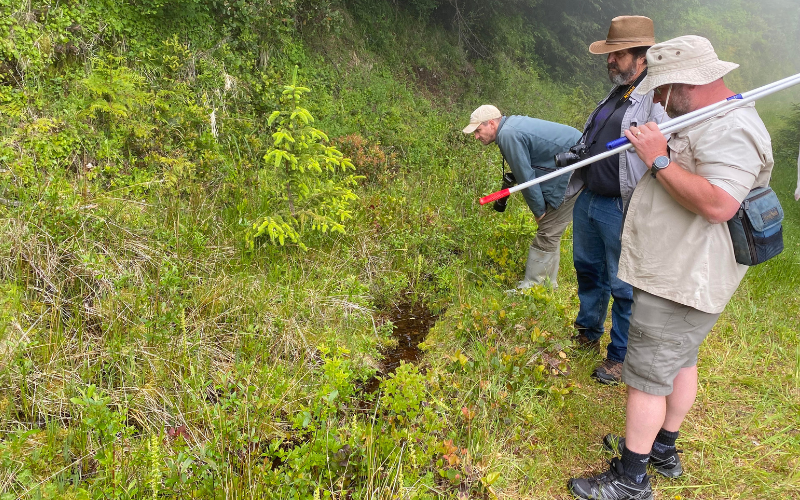
A black petaltail dragonfly in the Rainforest Reserve. Photo by Terri Neal
Dr. Christopher Beatty, an evolutionary ecologist, has been studying petaltail (Petaluridae)—a rare family of dragonflies—for more than a decade. It started when he was a master’s student at Oregon State University and researching dragonflies that use wetland habitat in the Willamette Valley as part of a larger restoration project surrounding salmon. During field visits to the Cascade Mountain Range, he was introduced to the black petaltail dragonfly (Tanypteryx hageni).
 In 2014, he and other research partners published a phylogeny that included 10 of the 11 species in the Petaluridae family, looking at how they relate to one another and how the group evolved over time.
In 2014, he and other research partners published a phylogeny that included 10 of the 11 species in the Petaluridae family, looking at how they relate to one another and how the group evolved over time.
The results suggest that the family is extremely old, first appearing about 160 million years ago along the southern and western coasts of the supercontinent Pangaea.
According to Christopher, the current distribution and diversity in the family appears to be the result of continental drift and other major geologic events: the black petaltail separated from the gray petaltail (Tachopteryx thoreyi) in eastern North America around 100 million years ago, when the Western Interior Seaway formed across North America. Meanwhile, the Tanypteryx pryeri—a sister species to the black petaltail that occurs in Japan—separated around 75 million years ago, likely as a northern land bridge that existed between the continents of modern-day North America and Asia diminished.
“These are some amazing ages for these species,” Christopher says, adding most of the current groups of dragonflies appeared in the last 25 to 30 million years. “The petaltails are significant outliers. They are older than the mountain ranges they live in.”
The researchers have now assembled a genome for the black petaltail, which they plan to publish soon, and they also are doing a large-scale population analysis across Oregon and California, getting genomic data from about 200 individuals.
Researching in the Rainforest Reserve
In early July, Christopher visited North Coast Land Conservancy’s Rainforest Reserve with his wife Katie Harding, who is an entomologist and helps extensively with his research. They were accompanied by their son Thomas, along with a few NCLC staff and partners.
Christopher was interested in visiting the Rainforest Reserve because it encompasses habitat for the black petaltail dragonfly. He wanted to collect DNA samples for the individuals from the Coast Range populations to include in the study. Before that, his Oregon samples came exclusively from the Cascades or Klamath ranges.
He looks forward to studying how coastal populations relate to diversity across the species. It’s especially intriguing because the petaltail nymphs generally take five years to develop into adults, and then they live for a very short time span.
“We started wondering, what are the implications of this,” he says. “You’d only be able to mate with individuals born the same summer as you. We have to think of these different cohorts [of petaltail] as different populations.”
He is curious if the five years of development is fixed, or if there is some elasticity, and what the implications are of the species’ long development times on the population and distribution. They also want to explore if type of habitat influences the length of development.
“These dragonflies don’t fly very well,” Katie says. “Our experience is they don’t seem to move very much. They stay close to specialized nymph habitats.”

Dr. Christopher Beatty (from right), scientist Mike Patterson and NCLC Land Steward Eric Owen search for black petaltail nymphs in the Rainforest Reserve.
During their Rainforest Reserve visit, they searched around spots that NCLC staff and research partners have previously identified as petaltail habitat. Katie was able to extract a nymph, along with exuviae—the cast-off exoskeleton as a nymph becomes an adult.
Christopher and Katie plan to continue exploring how genetically isolated the petaltail populations are and what makes them unique from other dragonflies. Other major collaborators on the project include Jessica Ware, an assistant curator in invertebrate zoology at the American Museum of Natural History, and student researcher Ethan Tolman.
“Once we get more of the Washington and British Columbia data, we’ll be able to look at the overall genetic diversity,” Christopher says. The DNA from the Rainforest Reserve petaltails will also lend itself to the comparison and help them inevstigate how the population got to where it was. “For us, having that very unique population, knowing it’s in a place that’s protected, is very exciting.”
Because there is little nymph habitat in the Oregon Coast Range, “it’s so wonderful that the Rainforest Reserve exists,” he says. “The special nature of this Oregon coastal population really deserves some attention.”
Learn more about Christopher’s research projects here.
Comments